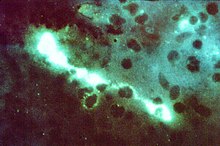Chlamydophila psittaci
| Chlamydophila psittaci | |
|---|---|
 |
|
| Direct fluorescent antibody stain of a mouse brain impression smear showing C. psittaci. | |
| Scientific classification | |
| Domain: | Bacteria |
| Phylum: | Chlamydiae |
| Order: | Chlamydiales |
| Family: | Chlamydiaceae |
| Genus: | Chlamydia |
| Species: | C. psittaci |
| Binomial name | |
|
Chlamydia psittaci |
|
Chlamydia psittaci is a lethal intracellular bacterial species that may cause endemic avian chlamydiosis, epizootic outbreaks in mammals, and respiratory psittacosis in humans. Potential hosts include feral birds and domesticated poultry as well as cattle, pigs, sheep and horses. Chlamydia psittaci is transmitted by inhalation, contact or ingestion among birds and to mammals. Psittacosis in birds and in humans often starts with flu-like symptoms and becomes a life-threatening pneumonia. Many strains remain quiescent in birds until activated under stress. Birds are excellent, highly mobile vectors for the distribution of chlamydia infection, because they feed on, and have access to, the detritus of infected animals of all sorts.
Chlamydia psittaci was previously classified as Chlamydophila psittaci. The former "mammalian" Chlamydia psittaci abortion, feline and Guinea pig strains have been moved to three new species. (See Chlamydia abortus, Chlamydia felis and Chlamydia caviae.)
C. psittaci in birds is often systemic and infections can be inapparent, severe, acute or chronic with intermittent shedding.C. psittaci strains in birds infect mucosal epithelial cells and macrophages of the respiratory tract. Septicaemia eventually develops and the bacteria become localized in epithelial cells and macrophages of most organs, conjunctiva, and gastrointestinal tract. It can also be passed in the eggs. Stress will commonly trigger onset of severe symptoms, resulting in rapid deterioration and death. C. psittaci strains are similar in virulence, grow readily in cell culture, have 16S rRNA genes that differ by <0.8%, and belong to eight known serotypes. All should be considered to be readily transmissible to humans.
...
Wikipedia
